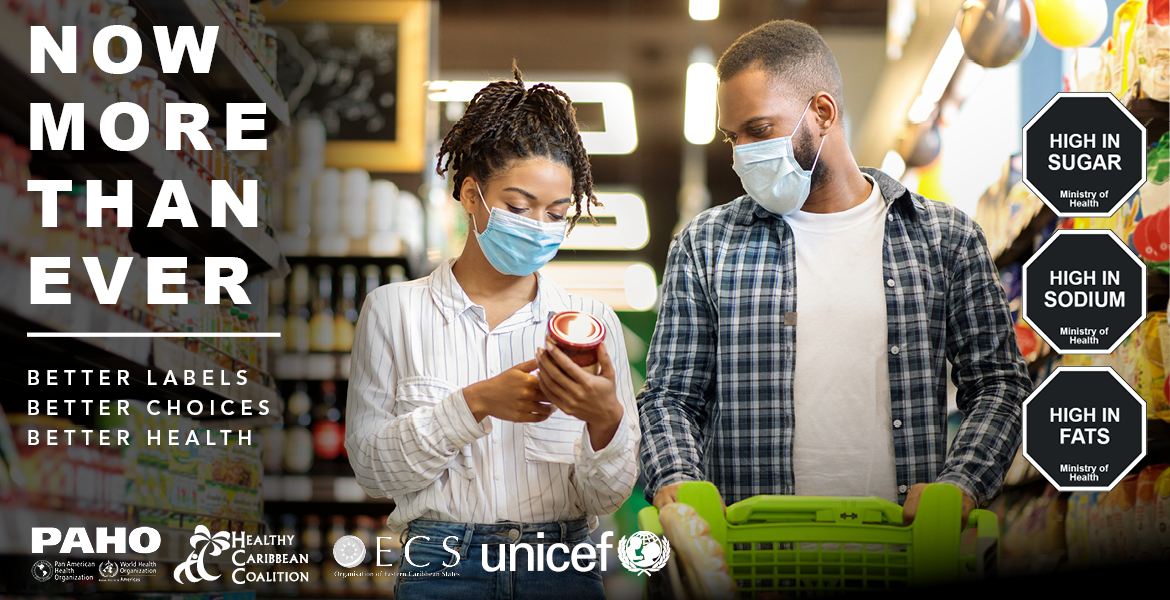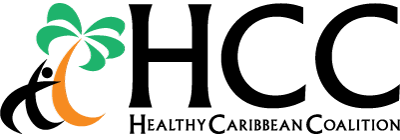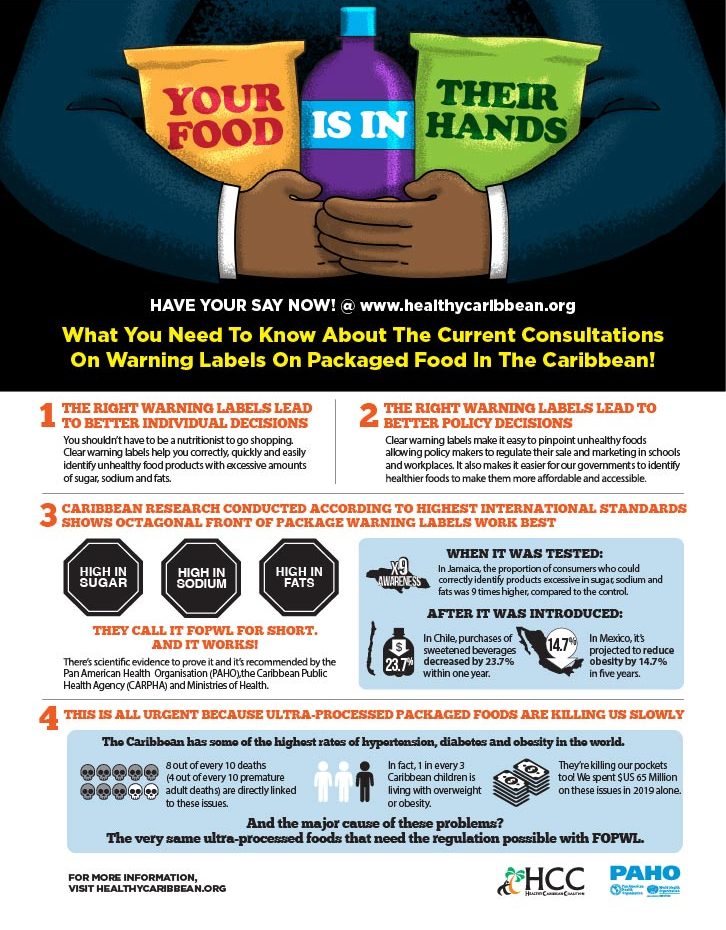An UPDATE on the Regional Standard for Labelling of Pre-Packaged Foods

Since September 2022, national representatives have been participating in consultations across the region. The coming weeks and months will be critical for regional public health as we await the outcome of the national deliberations. From a public health perspective, a win is a recommendation to retain the Standard in its current format with the octagonal ‘high in’ warning label as the singular recommended labelling scheme guided by the PAHO nutrient profile model. Will we see a collective reckoning with CARICOM uniting around an agenda that places public health first? HCC will be working with partners at the regional level and at the national level including Ministries of Health and civil society organisation members, to ensure that the public health perspective is prioritised in the deliberations.
For more on Front of Package Warning Labelling please visit our dedicated webpage here.
What is happening right now?
As of early November 2022, across the region, Caribbean countries are once again deliberating on whether or not to support the right of Caribbean citizens to have the best available front of package nutritional labelling model on their packaged foods. Through their local Standards Bureaus, National Mirror Committees in eleven (11) Member States are reviewing the Draft CARICOM Regional Standard for Specification for labelling of pre-packaged foods (DCRS 5:2010) which incorporates specifications for the ‘high-in’ monochromatic octagonal front of package warning label system (OWL) and the PAHO Nutrient Profile Model to guide the thresholds for labelling of pre-packaged foods as ‘high-in’.
The Standard meets the highest level of scientific rigor including the selection of the octagonal warning label and the PAHO nutrient profile model. There is a growing body of conflict of interest-free, scientific evidence which consistently supports the OWL as the best labelling model for empowering consumers to easily, correctly and quickly identify unhealthy foods ‘high in’ sodium, fats and sugars. The OWL is also supported by a 2021 randomized controlled trial of adult shoppers conducted in Jamaica which examined the best performing front-of- package labelling (FOPL). The study was undertaken by the University of Technology, the Jamaica Ministry of Health and Wellness and the Pan American Health Organisation (PAHO). The study found that the OWL consistently outperformed other labelling models (magnifying glass, UK traffic light, and GDA facts up front) helping Jamaican consumers to better identify foods ‘high in’ sodium, fats and sugars.
 Wasn’t there a vote on this Standard last year? What was the outcome?
Wasn’t there a vote on this Standard last year? What was the outcome?
Last year, in 2021, all 15 CARICOM Member States were asked to vote on whether or not they approved the then Final Standard (FDCRS 5). Member States could approve, reject or abstain and a 75% vote of approval was needed to trigger escalation to the next stage of the Standard approval process. Ultimately 66% (6/9) of CARICOM countries voted in favour just falling short of the 75% target (6 countries abstained, 3 opposed, and 6 approved the Standard). The vote was very close – had one of the 9 countries that either abstained or voted against the Standard, voted in favour, then the 75% target would have been achieved. The inability to achieve consensus stalled the process and thrust it back into the consultations phase, further extending a long and exhaustive consultative period that began in 2018.
Why do we need more consultations? What has changed?
The consultations have recently resumed with Member States now being asked to make recommendations on what should be done with the Standard given the release of a study designed and implemented by the recently formed Caribbean Private Sector Organisation (CPSO) with the Caribbean Community (CARICOM) Secretariat, and the Caribbean Agricultural Health and Food Safety Agency (CAHFSA). The CPSO, an Official Associate Institution of CARICOM, represents, amongst other sectors, the region’s food and beverage manufacturing sector. So the national deliberations are now being informed by two studies: the first study was conducted by an academic institution (University of Technology Jamaica) in partnership with national (Ministry of Health and Wellness Jamaica) and regional (PAHO) health authorities. The second study was conducted by a regional private sector umbrella organisation representing national private sector entities including those – the ultra-processed food and beverage sector – with a vested interest in the outcome of the study.
 Better Labels, Better Choices, Better Health – why we need strong evidence-based front of package warning labelling
Better Labels, Better Choices, Better Health – why we need strong evidence-based front of package warning labelling
Noncommunicable diseases (NCDs) are the leading causes of sickness, death and disability in the Caribbean. Rates of overweight and obesity are among the highest in the world and most worrying among children where 1 in 3 children and adolescents is living with overweight or obese. Unhealthy diets are a major risk factor contributing to the high rates of obesity and NCDs. Unhealthy diets are fueled by the widespread availability, accessibility, affordability, desirability, and consumption of ultra-processed products which contain high levels of “critical nutrients” of public health concern, namely sugars, total fats, saturated fats, trans fats and sodium.
The OWL empowers consumers of all ages, literacies and those living with NCDs, to quickly identify and avoid foods which are ‘high in’ sodium, fats and sugars. Other labelling schemes such as the traffic light or the GDA (facts up front) do not present this information. Instead they tell you the amount of grams of these nutrients (sodium, fats, sugars) and most consumers are unable touse this information to determine if the product is healthy or not, it only allows them to compare between unhealthy products.
Front of package warning labelling is also an enabling foundational policy which allows governments to easily identify those foods and beverage products which need to be regulated (restricted in schools for example) in order to support consumers in making the healthy choice the easy choice.
There is strong regional support for the OWL. Last year HCC, PAHO, the OECS Commission and UNICEF, implemented a regional campaign in support of the octagonal ‘high in’ warning labels – Better Labels, Better Choices, Better Health. The campaign was supported by almost 50 regional organisations and over 340 regional health professionals.
The Fate of the Warning Labelling in CARICOM
Since September 2022, national representatives have been participating in consultations across the region. The coming weeks and months will be critical for regional public health as we await the outcome of the national deliberations. From a public health perspective, a win is a recommendation to retain the Standard in its current format with the octagonal ‘high in’ warning label as the singular recommended labelling scheme guided by the PAHO nutrient profile model. Will we see a collective reckoning with CARICOM uniting around an agenda that places public health first? HCC will be working with partners at the regional level and at the national level including Ministries of Health and civil society organisation members, to ensure that the public health perspective is prioritised in the deliberations
For more on Front of Package Warning Labelling please visit our dedicated webpage here.

